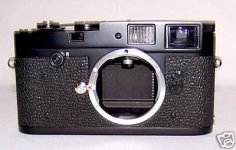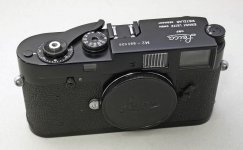Best way of learning to use a M2 is probably a 20 pack of what ever film you intend to use, a handheld meter and shoot the whole thing in a couple of days. Initially you will meter for every shot, soon you will only use the meter when you are not 100% sure and after 10-15 rolls, you will realize that you haven't used the meter at all!!! Thats when it gets to be fun. Yes, there will be foul ups - but probably only by 1/2 stop to 1 stop and the film can probably handle that. No better learning tool than telling yourself that "OK, it is a long week end and I have 20 rolls to shoot" Tell the family that you dont want to deal with them, turn of the cell-phone and think about an area around were you live and "cover" it photographically. Preferably stick to one lens too and enjoy yourself.
I think that's an excellent idea.
I spent decades using SLRs with TTL metering, and though I knew quite a bit about how exposure works in theory, I never really gained any skills in evaluating exposures.
I first tried a hand-held meter when I got a couple of FSU cameras and a Leningrad 8 meter, and the first time I went out with that meter I thought it was a nightmare - metering every shot like that was much more time-consuming than with a TTL meter. And to make matters worse, the clouds wouldn't stay put while I was trying to meter and shoot, and the brightness would change between me metering and lifting the camera to my eye! (With a TTL meter I'd fiddle with the aperture until the very moment of the shot, or with AE metering I'd watch the camera's fiddling with the shutter speed).
But it wasn't very long before it struck me that I what I really needed to do was take a few meter readings (one with the sun out, one with it behind a cloud, etc), to find out what the range of exposures was, then once I knew there was three stops difference (or whatever it was), I could take a number of shots within that range without metering each individual one.
And now when I go out, like this morning, with my M2 and Gossen Digisix (it's 32 deg C here today
😉 ), I find I don't really meter individual shots at all, I meter scenes, and instead of getting to know what the exposure is for each successive field of view through my VF, I'll get to know what the exposure values are for my surroundings. I'll check an incident reading, then a couple of reflective readings from highlights and shadows, and I'm set - unless the light changes dramatically, I can estimate the exposure from shot to shot within the range that I now know. So, quite often, I'll start with a new roll of film, do a bit of metering, and then shoot the whole film while walking around without getting the meter out again. And although I'm sure very few of my exposures are perfect (not that there is any such thing as an objectively perfect exposure, of course), I almost never get a duff shot - I get whole rolls of easily-scanned negatives.
Because of that experience, I'd personally recommend getting a hand-held meter rather than a camera-mounted one, for two reasons. Firstly, I think a camera-mounted one can be a bit of an intrusion the way TTL meters are - it's always there and you see it every shot, and so the temptation to meter every shot is greater. And secondly, you can do incident metering with a hand-held - and incident metering really made a big difference to the way my intuitive understanding of the exposure values around me has improved.





